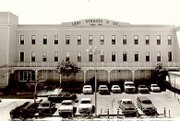Levi Strauss Winding Down U.S. Operations
San Francisco-based denim giant Levi Strauss & Co. announced plans this week to close six U.S. manufacturing facilities and lay off approximately 3,300 workers by October.
The company said its decision to scale back on U.S. production is part of its effort to gradually redefine its role as the country’s oldest brand name.
“We are slowly shifting away from being a manufacturer, and now we’re beginning to focus our resources on marketing and product development,” said Linda Butler, company spokeswoman.
This is the second large San Francisco apparel label to pull back its domestic operations this year. Last month, Esprit de Corp. announced plans to sell its trademark rights in the United States and the Caribbean region to its Hong Kong partner, Esprit Holdings Ltd., for $150 million, ending its 23-year presence as a manufacturer in San Francisco.
Over the past five years California apparel manufacturing employment has declined 16.5 percent, from 156,600 apparel jobs in 1996 to 130,700 apparel jobs last year, according to Jack Kyser of the Los Angeles Economic Development Corp.
Levi’s declined to say how much it would save as a result of the cutbacks but stressed that the move was “necessary in order to maintain strong margins” and “balance its cost structure” in a highly competitive retail environment.
“Lower costs are certainly a factor that we considered in our decision to outsource our production,” Butler explained. “It is more expensive to run your own factory in the U.S. versus having contractors in other countries.”
With the scaleback, the company will have just two production facilities remaining in the United States. Those facilities are a sewing plant and a finishing center, both located in San Antonio, Texas. However, the company said it plans to reduce its work force at the finishing center by 300 employees.
Levi’s move to shutter nearly all of its U.S. operations signifies a pivotal point for the company’s future, Butler said. The company began redefining its role in 1999, when it decided to close nine plants on the East Coast and one in Texas.
Butler said Levi’s overall production would not be affected since the company currently manufactures through contractors in more than 50 countries, including Pakistan, Hong Kong, India, Korea, New Zealand, the Philippines, Singapore, Taiwan and Thailand.
Beginning in June, the company plans to close its Blue Ridge, Ga., and San Francisco operations. Built in 1906, the Valencia Street facility in San Francisco is where Levi Strauss opened its first company headquarters, and about 100 sewing operators are currently employed there.
The company said the building’s future use has not been determined.
“There is a range of possibilities, we just haven’t really narrowed it down yet,” Butler said, adding that the company may decide to convert the building into a Levi’s history museum and make it a tourist destination or use the building as a product design center.
Meanwhile, the company claims it has put together a comprehensive severance package to help employees who are laid off. Butler said it has completed negotiations with United Food and Commercial Workers, which represents about 1,000 workers at the company’s Powell, Tenn., and San Francisco plants.
Butler said Levi’s is in negotiations for the final terms of the severance package for the workers of four closing facilities who are represented by the Union of Needletrades Industrial and Textile Employees.
The company, which is the maker of branded jeans and casualwear under the Levi’s and Dockers brands, reported a steady decline in revenues from $5.1 billion in sales for 1999 to $4.3 billion in sales for 2001. —Claudia Figueroa






















